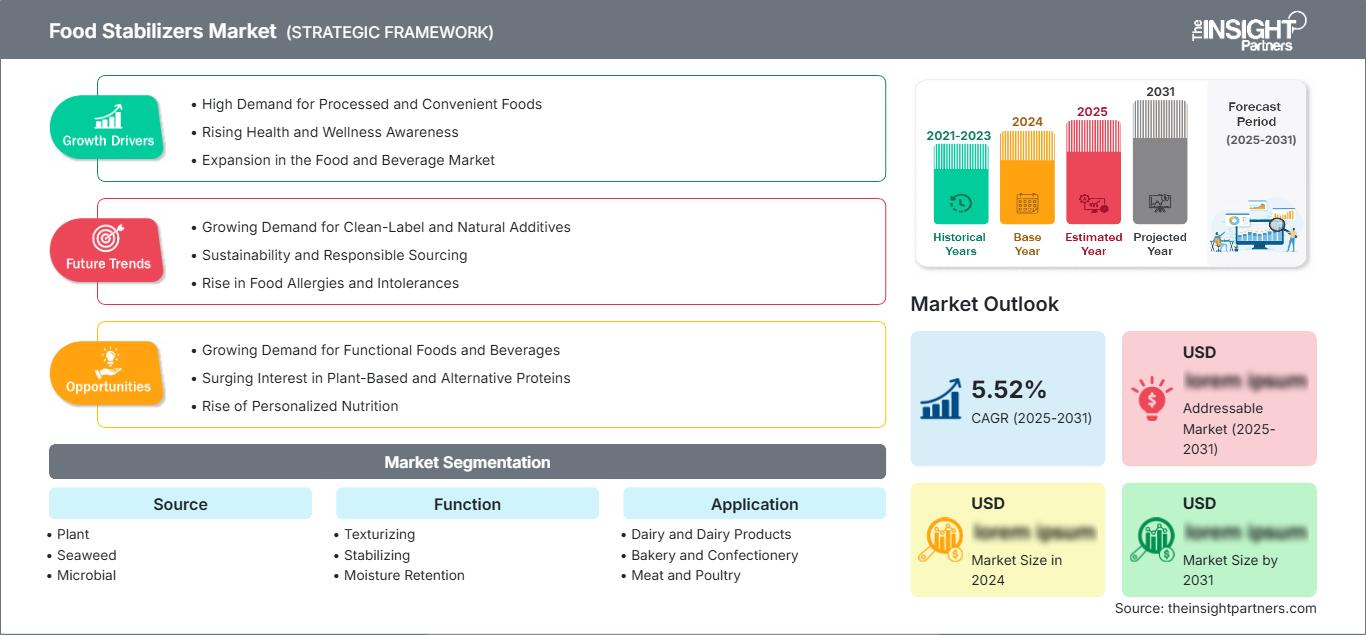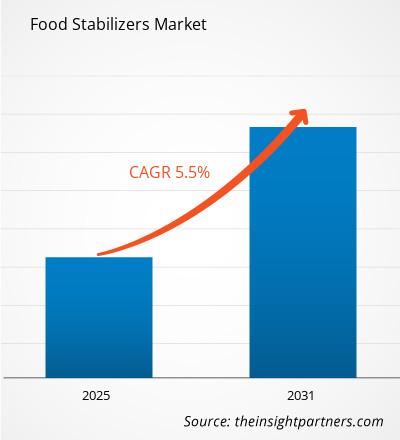Si prevede che il mercato degli stabilizzanti alimentari registrerà un CAGR del 5,52% dal 2025 al 2031, con una dimensione del mercato in espansione da XX milioni di dollari nel 2024 a XX milioni di dollari entro il 2031.
Il rapporto sul mercato degli stabilizzanti alimentari è segmentato per fonte in vegetali, alghe, microbici, animali e sintetici. Il segmento funzionale include testurizzazione, stabilizzazione e ritenzione di umidità. Il segmento applicativo include latticini e prodotti caseari, prodotti da forno e dolciumi, carne e pollame e bevande. La valutazione del mercato è presentata in dollari USA per l'analisi segmentale di cui sopra. L'analisi globale è suddivisa a livello regionale e per i principali paesi. La valutazione del mercato è presentata in dollari USA per l'analisi segmentale di cui sopra.
Scopo del rapporto
Il rapporto sul mercato degli stabilizzanti alimentari di The Insight Partners mira a descrivere il panorama attuale e la crescita futura, i principali fattori trainanti, le sfide e le opportunità. Ciò fornirà spunti a vari stakeholder aziendali, come:
- Fornitori/produttori di tecnologia: per comprendere le dinamiche di mercato in evoluzione e conoscere le potenziali opportunità di crescita, consentendo loro di prendere decisioni strategiche informate.
- Investitori: per condurre un'analisi completa delle tendenze in merito al tasso di crescita del mercato, alle proiezioni finanziarie del mercato e alle opportunità esistenti lungo la catena del valore.
- Organismi di regolamentazione: per regolamentare le politiche e le attività di controllo nel mercato con l'obiettivo di ridurre al minimo gli abusi, preservare la fiducia degli investitori e sostenere l'integrità e la stabilità del mercato.
Fonte di segmentazione del mercato degli stabilizzanti alimentari
- Vegetale
- Alghe
- Microbico
- Animale
- Sintetico
Funzione
- Testurizzante
- Stabilizzante
- Ritenzione di umidità
Applicazione
- Latticini e prodotti caseari
- Prodotti da forno e dolciumi
- Carne e pollame
- Bevande
Geografia
- Nord America
- Europa
- Asia-Pacifico
- Sud e Centro America
- Medio Oriente e Africa
Potrai personalizzare gratuitamente qualsiasi rapporto, comprese parti di questo rapporto, o analisi a livello di paese, pacchetto dati Excel, oltre a usufruire di grandi offerte e sconti per start-up e università
Mercato degli stabilizzanti alimentari: Approfondimenti strategici

- Ottieni le principali tendenze chiave del mercato di questo rapporto.Questo campione GRATUITO includerà l'analisi dei dati, che vanno dalle tendenze di mercato alle stime e alle previsioni.
Fattori di crescita del mercato degli stabilizzanti alimentari
- Elevata domanda di alimenti trasformati e convenienti: la crescente domanda di prodotti alimentari trasformati e convenienti, trainata da stili di vita frenetici e dall'aumento del reddito disponibile, è un fattore chiave per il mercato degli stabilizzanti alimentari. Gli stabilizzanti alimentari sono fondamentali per migliorare la consistenza, il sapore e la durata di conservazione, rendendoli ingredienti essenziali nei prodotti alimentari.
- Crescente consapevolezza di salute e benessere: la crescente consapevolezza dei consumatori in materia di salute e benessere sta alimentando la domanda di prodotti alimentari naturali e a etichetta pulita. Questo passaggio verso opzioni più salutari sta guidando l'adozione di stabilizzanti alimentari di origine naturale, come gomme e amidi vegetali, che sono percepiti come dotati di migliori profili di salute e conformità normativa.
- Espansione nel mercato alimentare e delle bevande: la continua espansione del mercato alimentare e delle bevande, insieme all'introduzione di nuovi prodotti alimentari, sta creando maggiori opportunità per gli stabilizzanti alimentari. Poiché i consumatori ricercano esperienze alimentari diverse e uniche, i produttori stanno incorporando stabilizzanti alimentari per sviluppare prodotti con attributi sensoriali migliorati.
Tendenze future del mercato degli stabilizzanti alimentari
- Crescente domanda di additivi naturali e clean-label: il mercato degli stabilizzanti alimentari è trainato da una crescente domanda di additivi naturali e clean-label. I consumatori stanno diventando più selettivi, spingendo i produttori a concentrarsi su stabilizzanti alimentari di origine naturale come gomme e amidi di origine vegetale.
- Sostenibilità e approvvigionamento responsabile: l'approvvigionamento sostenibile e responsabile degli stabilizzanti alimentari sta acquisendo importanza nell'industria alimentare. Gli stabilizzanti derivati da fonti sostenibili, così come quelli raccolti in modo responsabile, probabilmente vedranno una crescente popolarità sia tra i produttori che tra i consumatori.
- Aumento di allergie e intolleranze alimentari: la crescente prevalenza di allergie e intolleranze alimentari sta guidando lo sviluppo di stabilizzanti alimentari ipoallergenici e privi di allergeni. Per soddisfare queste specifiche esigenze dei consumatori, i produttori stanno investendo in ricerca e sviluppo per creare soluzioni adeguate.
Opportunità di mercato per gli stabilizzanti alimentari
- Crescente domanda di alimenti e bevande funzionali: la crescente domanda di alimenti e bevande funzionali, in particolare quelli arricchiti con vitamine, minerali e probiotici, ha creato nuove opportunità per gli stabilizzanti alimentari. Questi stabilizzanti contribuiscono a mantenere l'integrità, la stabilità e l'efficacia di tali prodotti.
- Crescente interesse per le proteine vegetali e alternative: la crescente popolarità delle diete a base vegetale e delle fonti proteiche alternative sta determinando la necessità di stabilizzanti alimentari in grado di migliorare la consistenza, il gusto e la consistenza di questi prodotti, aprendo nuove strade all'innovazione nel mercato.
- Ascesa della nutrizione personalizzata: il crescente interesse per la nutrizione personalizzata e i prodotti alimentari personalizzati offre opportunità per soluzioni di stabilizzanti alimentari su misura per le specifiche esigenze dei consumatori. I produttori possono sviluppare formulazioni innovative basate sulle preferenze e sulle esigenze dietetiche di diversi segmenti di consumatori.
Approfondimenti regionali sul mercato degli stabilizzanti alimentari
Le tendenze regionali e i fattori che influenzano il mercato degli stabilizzanti alimentari durante il periodo di previsione sono stati ampiamente spiegati dagli analisti di The Insight Partners. Questa sezione illustra anche i segmenti e la geografia del mercato degli stabilizzanti alimentari in Nord America, Europa, Asia-Pacifico, Medio Oriente e Africa, America meridionale e centrale.
Ambito del rapporto di mercato sugli stabilizzanti alimentari
| Attributo del rapporto | Dettagli |
|---|---|
| Dimensioni del mercato in 2024 | US$ XX million |
| Dimensioni del mercato per 2031 | US$ XX Million |
| CAGR globale (2025 - 2031) | 5.52% |
| Dati storici | 2021-2023 |
| Periodo di previsione | 2025-2031 |
| Segmenti coperti |
By Fonte
|
| Regioni e paesi coperti | Nord America
|
| Leader di mercato e profili aziendali chiave |
|
Densità degli operatori del mercato degli stabilizzanti alimentari: comprendere il suo impatto sulle dinamiche aziendali
Il mercato degli stabilizzanti alimentari è in rapida crescita, trainato dalla crescente domanda da parte degli utenti finali, dovuta a fattori quali l'evoluzione delle preferenze dei consumatori, i progressi tecnologici e una maggiore consapevolezza dei benefici del prodotto. Con l'aumento della domanda, le aziende stanno ampliando la propria offerta, innovando per soddisfare le esigenze dei consumatori e sfruttando le tendenze emergenti, alimentando ulteriormente la crescita del mercato.

- Ottieni il Mercato degli stabilizzanti alimentari Panoramica dei principali attori chiave
Punti di forza
- Copertura completa: il rapporto analizza in modo esaustivo prodotti, servizi, tipologie e utenti finali del mercato degli stabilizzanti alimentari, offrendo una panoramica olistica.
- Analisi degli esperti: il rapporto è redatto sulla base della conoscenza approfondita di esperti e analisti del settore.
- Informazioni aggiornate: il rapporto garantisce la pertinenza aziendale grazie alla copertura di informazioni e dati recenti.
- Opzioni di personalizzazione: questo rapporto può essere personalizzato per soddisfare le esigenze specifiche del cliente e adattarsi in modo appropriato alle strategie aziendali.
Il rapporto di ricerca sul mercato degli stabilizzanti alimentari può quindi aiutare a guidare il percorso di decodificazione e comprensione dello scenario del settore e delle prospettive di crescita. Sebbene possano esserci alcune preoccupazioni valide, i vantaggi complessivi di questo rapporto tendono a superare gli svantaggi.
- Analisi storica (2 anni), anno base, previsione (7 anni) con CAGR
- Analisi PEST e SWOT
- Valore/volume delle dimensioni del mercato - Globale, Regionale, Nazionale
- Industria e panorama competitivo
- Set di dati Excel
Report recenti
Rapporti correlati
Testimonianze
Motivo dell'acquisto
- Processo decisionale informato
- Comprensione delle dinamiche di mercato
- Analisi competitiva
- Analisi dei clienti
- Previsioni di mercato
- Mitigazione del rischio
- Pianificazione strategica
- Giustificazione degli investimenti
- Identificazione dei mercati emergenti
- Miglioramento delle strategie di marketing
- Aumento dell'efficienza operativa
- Allineamento alle tendenze normative




















 Ottieni un campione gratuito per - Mercato degli stabilizzanti alimentari
Ottieni un campione gratuito per - Mercato degli stabilizzanti alimentari